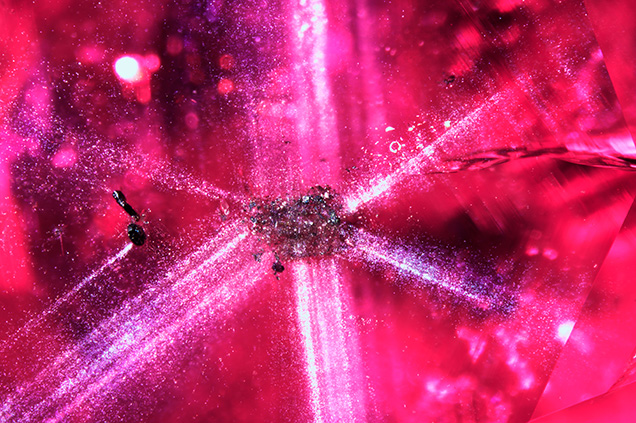Trapiche-Like Ruby from the Batakundi Mine, Kashmir

Recently, the author examined a 5.26 ct faceted transparent oval ruby that showed a well-formed fixed six-rayed pattern under the table of the stone. Chemical analysis and gemological observation of internal features determined the origin of this stone to be the Batakundi mining area of Kashmir.
The six rays were oriented perpendicular to the sides of the hexagonal growth structure (see above). Each arm consisted of numerous minute particles mixed with needle-like inclusions and small thin films. The center of the star contained a group of colorless and black mineral inclusions that were identified by Raman spectroscopy as feldspar and graphite. Near the core, two black crystals with high luster were identified by Raman spectroscopy as rutile. They were also associated with a string of fine particles spreading out to form a comet tail pattern.
The pattern of this ruby from the Batakundi mine resembles that of a trapiche-type sapphire from Tasmania (Winter 2016 GNI, pp. 430–431). Trapiche-like minerals are quite different from true trapiche rubies, which have six arms that run from a core to the six corners of the hexagonal growth structure and show clear boundaries of six crystallographic sectors. The most renowned of the true trapiche ruby can be found in certain areas such as Mong Hsu, Myanmar (G. Giuliani and I. Pignatelli, “‘Trapiche’ vs ‘trapiche-like’ textures in minerals,” InColor, Vol. 31, 2016, pp. 45–46).
Although trapiche-like corundum specimens are not unheard of, it is unusual to find them well developed in high-quality ruby. This trapiche-like ruby from the Batakundi area shows a beautiful inclusion scene of a fixed six-rayed star standing out against the pleasing bodycolor and transparency.



